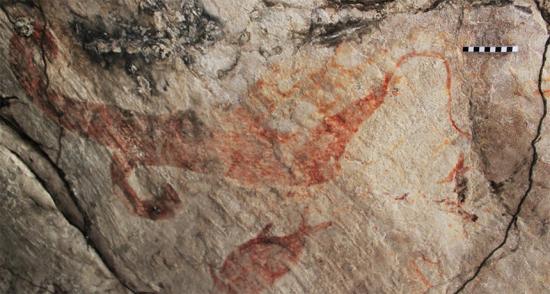Wasps’ nest dating technique suggests minimum age of 16,000 years
Bruce Bower
Source - https://www.sciencenews.org/article/painting-claimed-be-among-australia%E2%80%99s-oldest-known-rock-art
 Researchers say they have dated this ambiguous figure, painted on a cave ceiling in northwestern Australia, to at least 16,000 years ago. If that estimate holds up, it supports the idea that some of the continent’s earliest human inhabitants created rock art. J. ROSS ET AL., UNIV. OF NEW ENGLAND
Researchers say they have dated this ambiguous figure, painted on a cave ceiling in northwestern Australia, to at least 16,000 years ago. If that estimate holds up, it supports the idea that some of the continent’s earliest human inhabitants created rock art. J. ROSS ET AL., UNIV. OF NEW ENGLAND
Inside a large cave in northwestern Australia’s remote Kimberley region, someone painted an elongated, yamlike shape on a ceiling at least 16,000 years ago, new research suggests. That long-ago creation in the unnamed cavern adds fuel to the argument that rock art in Australia goes back even earlier to the continent’s first inhabitants, researchers contend.
This discovery joins a small number of drawings and paintings from Down Under that have been dated to around the same time or earlier, say archaeologist June Ross of the University of New England in Armidale, Australia, and colleagues. Some scientists have questioned the accuracy of these dates. But the new work, Ross’ team asserts, gives a critical boost to a previous, contested report that a piece of Kimberley rock art depicting a humanlike figure painted over a hand stencil dates to a minimum of about 16,400 years ago.
Ross’ group also obtained minimum age estimates, ranging from around 5,100 to 530 years, for nine other pieces of Kimberley rock art, the researchers report August 31 in PLOS ONE.
 Analyses of sand grains from mud wasps’ nests, such as the one circled, enabled scientists to estimate minimum ages for rock art in northwestern Australia. The kangaroo depiction shown here dates to at least around 5,100 years ago, researchers say.
Analyses of sand grains from mud wasps’ nests, such as the one circled, enabled scientists to estimate minimum ages for rock art in northwestern Australia. The kangaroo depiction shown here dates to at least around 5,100 years ago, researchers say.
People first reached Australia around 50,000 years ago (SN: 3/15/03, p. 173). Researchers generally assume the continent’s colonizers brought rock art traditions with them from Asia. In southeastern Australia’s Yaranda Cave, for instance, claw marks of a type of marsupial that died out around 50,000 years ago appear on top of pigmented human finger marks, says Robert Bednarik, an independent scholar and self-taught rock art authority based in Caulfield South, Australia. But it is difficult to accurately date such art.
Ross’ team — like the researchers who dated the humanlike figure — focused on dating sand grains found inside mud wasps’ nests that the insects built on cave walls and ceilings, covering parts of artistic depictions. Eventually, surviving nests fossilized. Light-induced release of radiation from sand grains in the lab enabled calculations of the time since each grain was last exposed to sunlight, providing a minimum age for the painting beneath the nest.
Four pieces of Kimberley rock art — but not the proposed 16,000-year-old painting — also yielded radiocarbon dates from bits of surviving nests and beeswax stuck to drawings.
Without a confirming radiocarbon date, the new minimum age estimate of 16,000 years for the yamlike Kimberley painting is provisional, Bednarik says. But the timeframe isn’t out-of-bounds. Mineral deposits partly covering hand stencils in an Indonesian cave date to nearly 40,000 years old (SN: 11/15/14, p. 6), although, similarly, no radiocarbon dates exist to confirm that. And researchers have known for decades that meandering impressions on the walls of Koonalda Cave in southern Australian, made by pigment-coated human fingers, must be older than 15,000 years, Bednarik says. The marked walls in Koonalda Cave became inaccessible after that time.
J. Ross et al. Into the past: a step towards a robust Kimberley rock art chronology. PLOS ONE. Published online August 31, 2016. doi:10.1371/journal.pone.0161726.